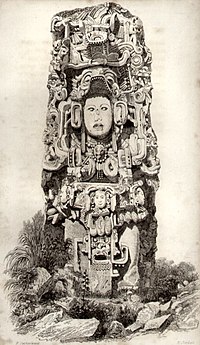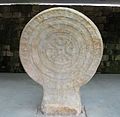Stele

A stele[1] is a stone or wooden slab, mostly taller than it is wide, that is built so that people will remember something when they look at it. Mostly it is decorated with the names and titles of the person that is a reminder of. This is inscribed, carved in relief or painted onto the slab.
History and function
[change | change source]Stelae were also used as territorial markers, as the boundary stelae of Akhenaten at Amarna,[2] or to commemorate military victories.[3] They were widely used in Mesopotamia, Greece, Egypt, Ethiopia, and, quite independently, in China and some Buddhist cultures, and by Mesoamerican civilisations, especially the Olmec[4] and Maya.[5] The huge number of stelae that survive from ancient Egypt and in Central America are one of the largest and most significant sources of information on those civilisations.
Unfinished standing stones, set up without inscriptions from Libya in North Africa to Scotland were monuments of pre-literate Megalithic cultures in the Late Stone Age.
An obelisk is a specialized kind of stele. The Celtic high crosses of Ireland, Scotland, and Wales are specialized stelae.The totem pole of North and South America is a type of stelae. Gravestones are also kinds of stelae.
In 2004 the architect Peter Eisenman created a field of some 2,700 blank stelae, the Memorial to the Murdered Jews of Europe in Berlin[6] to memory of the Holocaust.
Notable individual stelae
[change | change source]Gallery
[change | change source]-
Ancient Egyptian funerary stele
-
Healing stele of Horus-(a Cippus of Horus). Ptolemaic dynasty, c. 305-30 BC.
-
Sueno's Stone in Forres, Scotland
-
Maya stela, Quirigua
-
Kildalton Cross 800 AD Islay, Scotland
-
The Rosetta Stone in the British Museum
-
3-D view of Rosetta Stone-Left side
-
A Buddhist Stele from China, Northern Wei period, built in the early 6th century
Related pages
[change | change source]Bibliography
[change | change source]- John Boardman ed., The Cambridge Ancient History, Part 1, 2nd Edition, ISBN 9780521224963
- Christopher A. Pool, Olmec Archaeology and Early Mesoamerica, Cambridge University Press 2007 (ISBN 9780521783125)
- Karen E. Till, The New Berlin: Memory, Politics, Place, University of Minnesota Press 2005
Footnotes and references
[change | change source]- ↑ from Greek: στήλη, stēlē, English pronunciation: /ˈstiːli/; plural: stelae, Greek: στῆλαι, stēlai, English pronunciation: /ˈstiːlaɪ/; also found: Latinised singular stela and Anglicised plural steles
- ↑ Memoirs By Egypt Exploration Society Archaeological Survey of Egypt 1908, p. 19
- ↑ e.g. Piye's victory stela (M. Lichtheim, Ancient Egyptian Literature Vol 3, The University of California Press 1980, , pp.66ff) or Shalmaneser's stela at Saluria (Boardman, op.cit, p.335)
- ↑ Pool, op.cit., p.265
- ↑ Pool, op.cit., p.277
- ↑ Till, op.cit., p.168
Other websites
[change | change source]- Funerary Stela Archived 2009-04-10 at the Wayback Machine
Text is available under the CC BY-SA 4.0 license; additional terms may apply.
Images, videos and audio are available under their respective licenses.







